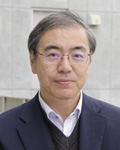Resistively-Detected NMR and Nuclear Resonance Imaging
Category
Published on
Abstract
NMR provides us versatile tool to physical, chemical, biological, and medical characterizations. However, conventional NMR suffers low sensitivity and cannot be applied to semiconductor quantum systems, such as single quantum well or wire. To overcome these difficulties, resistively-detected NMR(RDNMR)has been developed, especially for GaAs based quantum structures [1].
The Knight-shift gives us information of electron spin polarization and nuclear relaxation (T1time) includes information of electron spin fluctuations. Many interesting physics are unveiled in two-dimensional electron systems, especially in the quantum Hall regime. The clear difference between ground and second Landau-level is clarified by Knight-shift measurements up to high temperature regime where fractional quantum Hall effect disappears [2]. The RDNMR measurements can be applied to not only GaAs but InSb two-dimensional systems. The interesting characteristics of quantum Hall ferromagnet is clarified by using RDNMR studies in InSb quantum systems [3]. Nuclear-related measurements are also powerful to study interaction between ensemble of nuclear spins and electron spins. The obtained results suggest novel possibilities including a super-radiance from nuclear spin ensembles [4].
It is interesting that the RDNMR measurements can be extended in nanoscale characterization. A combination of scanning gate technique and RDNMR results in successful two-dimensional mapping of Knight-shift, i.e. electron spin polarization, using quantum Hall breakdown phenomenaas an example [5]. Successful RDNMR of one-dimensional quantum-point contacts [6] can be connected to sensitive detection of microscopic strain distribution in semiconductor quantum devices [7].
Bio
 Professor Yoshiro Hirayama received his Ph.D. from the University of Tokyo in 1983 and joined NTT Basic Research Laboratories. In NTT, he served as Group Leader, Distinguished Technical Member and Executive Manager. He was a guest scientist in Max-Planck-Institute (Stuttgart) during 1990-1991 and in Paul-Drude-Institute (Belrin) in 2004. He was appointed Professor at Tohoku University in 2006. He is now director, Center for Science and Innovation in Spintronics (CSIS), Tohoku University, and coordinator, Graduate Program in Spintronics (GP-Spin), Tohoku University. His current research interests are transport properties of semiconductor heterostructurs and nanostructures, especially putting emphasis on carrier interactions and coherent control including manipulation of nuclear spins in semiconductors. He received JJAP Best Paper Award (2004, 2008), ISCS Quantum Device Award (2013), and other awards. He has been Fellow of Institute of Physics (IOP, London) and Fellow of the Japan Society of Applied Physics (JSAP). He is also serving MEXT Grant-in-Aid for Scientific Research on Innovative Areas “Science of Hybrid Quantum Systems” (2015-2020) as project leader.
Professor Yoshiro Hirayama received his Ph.D. from the University of Tokyo in 1983 and joined NTT Basic Research Laboratories. In NTT, he served as Group Leader, Distinguished Technical Member and Executive Manager. He was a guest scientist in Max-Planck-Institute (Stuttgart) during 1990-1991 and in Paul-Drude-Institute (Belrin) in 2004. He was appointed Professor at Tohoku University in 2006. He is now director, Center for Science and Innovation in Spintronics (CSIS), Tohoku University, and coordinator, Graduate Program in Spintronics (GP-Spin), Tohoku University. His current research interests are transport properties of semiconductor heterostructurs and nanostructures, especially putting emphasis on carrier interactions and coherent control including manipulation of nuclear spins in semiconductors. He received JJAP Best Paper Award (2004, 2008), ISCS Quantum Device Award (2013), and other awards. He has been Fellow of Institute of Physics (IOP, London) and Fellow of the Japan Society of Applied Physics (JSAP). He is also serving MEXT Grant-in-Aid for Scientific Research on Innovative Areas “Science of Hybrid Quantum Systems” (2015-2020) as project leader.
Credits
These studies are supported by KAKENHI Grants Nos. 18H01811 and 15H05867
Sponsored by
References
- Y. Hirayama et al., Semicond. Sci. Technol. 24, 023001 (2009) [Topical Review]; Y. Hirayama, Chapter 38, Quantum Hall Effects (3rd Edition) (World Scientific, 2013).
- L. Tiemann et al., Science 335, 828 (2012); S. Hasegawa et al. (in preparation).
- H. W. Liu et al., Phys. Rev. B82, 241304(RC) (2010); K. F. Yang et al., Nature Comm. 8, 15084 (2017); K. F. Yang etal., New J.Physics 21, 083004 (2019).
- M. H. Fauzi et al., Phys. Rev. B90, 235308 (2014); Y. Hama et al., New J. Physics 18, 023027 (2016); Y. Hama et al., Phys. Rev. Lett. 120, 060403 (2018); M. H. Fauzi et al., (in preparation).
- K. Hashimoto et al., AIP Advances 6, 075024 (2016); K. Hashimoto et al., Nature Comm. 9, 2215 (2018).
- A. Noorhidayati et al., poster in this workshop.
- M. H. Fauzi et al., arXiv:1812.08935 [Phys. Rev. Lett. (under review)].
Cite this work
Researchers should cite this work as follows:
Time
Location
Burton Morgan, Room 121, Purdue University, West Lafayette, IN